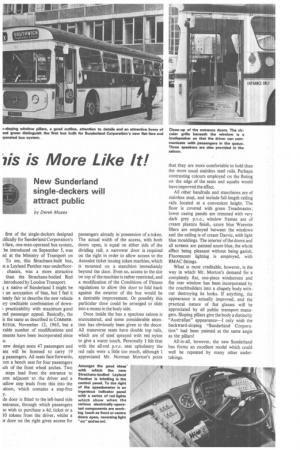',is is More Like It!
Page 33

If you've noticed an error in this article please click here to report it so we can fix it.
New Sunderland single-deckers will attract public
by Derek Moses
first of the single-deckers designed zifically for Sunderland Corporation's t-fare, one-man-operated bus system, be introduced on September 5, was ed at the Ministry of Transport on To me, this Strachans-built bus, in a Leyland Panther rear-underfloor chassis, was a more attractive than the Strachans-bodied Red introduced by London Transport.
g a native of Sunderland I might be an accusation of bias, but I feel it lutely fair to describe the new vehicle ry creditable combination of down
practicability with maxirhum good tnd passenger appeal. Basically, the is the same as described in COMMER40TOR, November 12, 1965, but a table number of modifications and unents have been incorporated since e.
new design seats 47 passengers and ses will be licensed to carry 19 g passengers. All seats face forwards, om a bench seat for four passengers ioh of the front wheel arches. Two steps lead from the entrance to orm adjacent to the driver and a tallow step leads from this into the aloon, which contains a step-free y.
de door is fitted to the left-hand side entrance, through which passengers io wish to purchase a 4(1. ticket or a 10 tokens from the driver, whilst a r door on the right gives access for passengers already in possession of a token. The actual width of the access, with both doors open, is equal on either side of the dividing rail; a narrower door is required on the right in order to allow access to the Autoslot ticket issuing token machine, which is mounted on a stanchion immediately beyond the door. Even so, access to the slot on top of the machine is rather restricted, and a modification of the Conditions of Fitness regulations to allow this door to fold back against the exterior of the bus would be a desirable improvement. Or possibly this particular door could be arranged to slide into a recess in the body side.
Once inside the bus a spacious saloon is encountered, and some considerable attention has obviously been given to the decor. All transverse seats have double top rails, which are of steel sprayed with red nylon to give a warm touch. Personally I felt that with the all-red p.v.c. seat upholstery the red rails were a little too much, although I appreciated Mr. Norman Morton's point that they are more comfortable to hold than the more usual stainless steel rails. Perhaps contrasting colours employed on the fluting on the edge of the seats and squabs would have improved the effect.
All other handrails and stanchions are of stainless steel, and include full-length ceiling rails located at a convenient height. The floor is covered with green Treadmaster, lower casing panels are trimmed with very dark grey p.v.c., window frames are of cream plastics finish, azure blue Warerite fillers are employed between the windows and the ceiling is of cream Darvic, with light blue mouldings. The interior of the doors and all screens are painted azure blue, the whole effect being pleasant without being garish. Fluorescent lighting is employed, with BMAC fittings.
What is most creditable, however, is the way in which Mr. Morton's demand for a completely flat, one-piece windscreen and flat rear window has been incorporated by the coachbuilders into a shapely body without destroying its looks. If anything, the appearance is actually improved, and the practical nature of flat glasses will be appreciated by all public transport managers. Sloping pillars give the body a distinctly "Australian" appearance—I only wish the backward-sloping "Sunderland Corporation" had been painted at the same angle as the pillars!
All-in-all, however, the new Sunderland bus forms an excellent model which could well be repeated by many other undertakings.
































































































































































